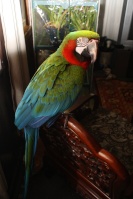Vikki
Scarlet Macaw

Join date : 2011-05-19
Age : 59
Location : BLAIRSTOWN NJ
My Birds : Sebastian - 7 yr old Harlequin Macaw
Arthur - 12 yr old Jardines Parrot
Pickle - 16 yr old Hahn's Macaw
Ecko - 26 yr old Hahn's Macaw
Plus the 180+ various bird from finch to Hyacinth at the rescue where I volunteer and live...
Posts : 811
 |  Subject: Jardine's Parrot : FAQ Subject: Jardine's Parrot : FAQ  Thu May 19, 2011 1:26 pm Thu May 19, 2011 1:26 pm | |
| Jardine’s Parrot
Poicephalus gulielmi
It is generally recognized that there are 3 and possibly a 4th subspecies of Jardine's Parrots. They are:
• P.g.gulielmi also known as the Black Wing Jardine in the US.
• P.g.fantiensis also known as the Lesser Jardine in the US. Most common in the U.S.
• P.g.massaicus also known as the Greater Jardine in the US.
• P.g.permistus
Length: 28cm/11 inches
Weight: 200-250 grams
Incubation: 26 days
Age at weaning: 12-14 weeks
Age at maturity: 3-4 years
Habitat: Cameroon, Kenya, Tanzania, Liberia and Central Africa
Feeding: Jardine’s require low fat low protein diets that are rich in vitamin A and calcium since they tend to be deficient there. Foods high in vitamin A (such as carrots, sweet potatoes, red peppers, other orange, red or dark green vegetables) are best for a Jardine’s diet with a mixture of nuts, pellets and fruits mixed in to their feeding.
Suitability as pets: Jardine’s make excellent companion birds since they are neither too small nor too large and can be worked in to most available spaces since they do not need a huge cage. Jardine’s are good flyers and naturally gymnastic climbers that like to foot forage, shred paper, hang by a toe or simply enjoy life. They are often lovable and enjoy a good cuddle but do not require a huge amount of attention all the time. When they are with you, they will play, talk and enjoy your company. When they are alone, they will amuse themselves when the need arises. They are good talkers, but better at sound effects and mimicry. They do not have loud voices but can emit high pitched whistles and calls.
Lifespan: 25-35 yrs
Sexing: DNA or surgical is the only sure way but visual sexing can be attempted, in some birds the head of the male is larger and flatter on the crown also the iris of the male is a rusty orange color and in the female it is a more brownish orange.
| |
|

